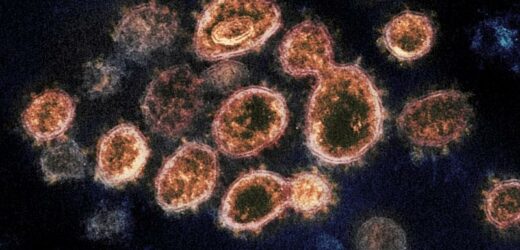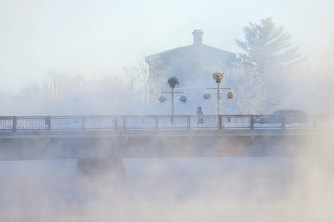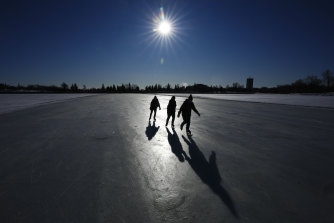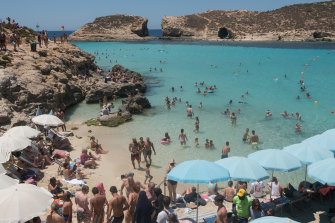For our free coronavirus pandemic coverage, learn more here.
Washington: COVID-19 transmission may have seasonal spikes tied to temperature and humidity, increasing at different times of the year for different locations, a new study suggests.
Colder regions, such as the US Northeast, may experience more cases during winter, while warmer regions, such as the southern United States, may see higher transmissions in the summer. More temperate zones could experience two seasonal peaks.
COVID peaks at different times in different climates, one study suggests. A pedestrian walks near the Mississippi River in the Ottawa Valley in Carleton Place, Ontario. Credit:AP
“We think COVID may be becoming endemic, meaning that it will stay within the human population, but we will see spikes based on where we are in a particular geographic point,” said author Antar Jutla, a hydrologist at the University of Florida. “The severity of peaks will be defined by how colder the temperature is and how warmer the temperature is.”
Jutla and his colleagues found that COVID cases in 19 hot spots worldwide increased above and below certain temperature and humidity thresholds, due to the virus’s movement as an aerosol and human behaviour. Cases spiked when air temperatures dipped below 17 Celsius or above 75 degrees 24 Celsius. The virus also tends to linger more in drier environments compared to humid ones.
“We need to basically design the intervention or mitigation strategies based on the environment in which we live,” said Jutla. “Regions like Florida, India, Africa – they are warm regions…. They basically get hit by these waves, but at different times than what happens in the northern parts, the colder regions.”
Skater brave the cold to lace up the blades on opening day of the Rideau Canal Skateway in Ottawa, Ontario.Credit:AP
While cases could pop during extreme chills or heat waves, Jutla said such temperatures typically need to persist for about a 14-day average. The team validated the data to December 2021, but characteristics could change with new mutations or new variants.
Aerosol researcher and co-author Chang-Yu Wu explained that local humidity and temperature play vital roles in the size of the virus’s particles, which can influence its life span in the air. Drier atmospheres in colder regions will induce water evaporation from the particles, shrinking their size and allowing them to float in the air for longer periods. People also tend to seek shelter inside in colder environments and expose themselves to recirculated air that potentially contains the virus.
Humid, hotter environments contain more water content in the air, which can condense onto the virus particles, make them bigger and theoretically fall to the ground faster. Wu compares the particles to a rock in this case – the more mass, the faster it falls. At the same time, people often move inside to avoid the warmth and again expose themselves to recirculated air. Air conditioners also dry the inside air, creating an environment similar to that of winter for aerosols.
“Human behaviour is a very important factor in the transmission,” said Wu, who is also a professor at the University of Florida. “It’s not just purely the physics or biology [of the virus] that dictates…. It’s a combination of these.”
Fewer cases were detected between 17 to 24 degrees, considered more tolerable temperatures for people to be outside.
“This study confirms the previous findings of seasonality with SARS-CoV-2 infection (low temperature and humidity),” Mohammad Sajadi, a professor at the Institute of Human Virology at the University of Maryland School of Medicine, wrote in an email. “It also adds to our knowledge about transmission in warmer temperatures.” Sajadi was not involved in the study.
He said more work is needed to further explore the use of indoor air conditioning, stating that “the United States and India likely have different levels of usage, which was not accounted for in this study.”
“If anything, [the study] again shows us how complicated the issue of seasonality is,” Sajadi wrote.
Sajadi compared the findings to the seasonality, or climatic conditions, of influenza as well. For influenza infections, he said the stability of aerosols also occurs at two vastly different levels of humidity. The different patterns of seasonality depend on the geographic locale, too.
Others found the climate-COVID relationships in different locations plausible as well.
“I like that the study points out that climate-COVID relationships will differ by region,” emailed Ben Zaitchik, co-chair of a COVID-19 research task team at World Meteorological Organisation and not involved in the study. “We found something similar in a study . . . and I think it’s important to emphasise.”
He also stressed that linking climate to COVID risk is an evolving field of research. Several studies with other climate-COVID mechanisms have been published in the past few months, including one discussing the challenges of studying such an area.
It is important to remember that these are only one driver of risk, wrote Zaitchik. “All evidence is that it has been a secondary driver up to this point in the pandemic. It might become more important as COVID becomes endemic and settles into a seasonally locked pattern – which many expect that it will.”
Summer in Malta, in late July.Credit:Getty Images
Considering the virus’s environmental and socioeconomic influences, Jutla and colleagues also created a model to predict the risk of COVID in the United States weekly.
The model, currently in the beta phase, includes air temperature, humidity, population density, economic stability (income), age, diversity, housing, vaccination data sets and more. The predictive model builds on work by Jutla and other co-authors, who previously demonstrated how cholera outbreaks are tied to environmental factors such as air temperature and salinity.
“Social behavioral sciences need to be strongly intertwined with the natural sciences,” said co-author Rita Colwell, a biologist at the University of Maryland who helped uncover the role the environment plays in cholera transmission. “The intersection of the physical environment and human behaviour in warm and cold regions is exemplified in the COVID case reports.”
The model runs around 80 to 90 per cent accuracy nationwide (validated on a US county-level scale), although Zaitchik said it is important to see the model in a peer-reviewed form especially because of the model’s novelty. “There hasn’t been any robust demonstration of a model like that for COVID-19 risk prediction,” he said.
Overall, the researchers stressed that proper ventilation and filtration, such as masks, are among the most important measures for preventing transmission of the disease. Air sampling studies have repeatedly shown that excellent ventilation and filtration can reduce COVID case loads, even in larger, relatively crowded places such as gyms.
“For me, the biggest takeaway is the need to focus on the built environment,” Zaitchik wrote. “It’s not simply a matter of ‘is it cold out’; it’s a matter of whether those cold temperatures are leading you to crowd indoors, reduce ventilation, use climate controls that result in low indoor humidity, etc.”
Washington Post
Get a note directly from our foreign correspondents on what’s making headlines around the world. Sign up for the weekly What in the World newsletter here.
Most Viewed in World
From our partners
Source: Read Full Article





